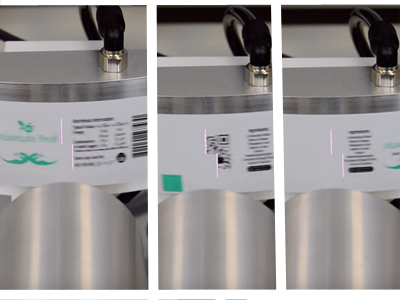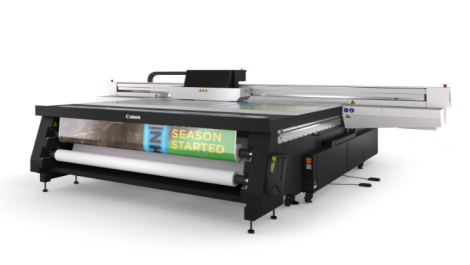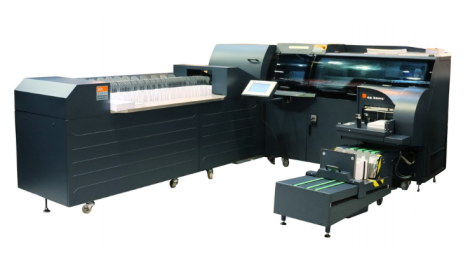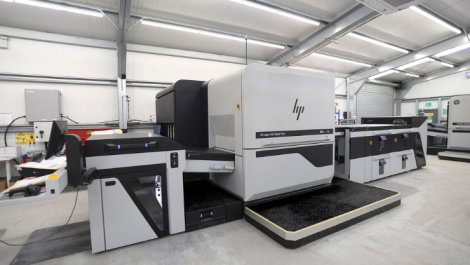Laser imaging of special colour changing inks offers an interesting option for high-speed customisation, especially where inkjet may not be practical. By Simon Eccles.
When is digital printing not digital, and not printing? The answer is when laser imaging is used. This technology combines applying a special ink or coating using conventional print processes, which is imaged when dry using a laser to initiate a colour change.
At drupa the UK company DataLase will unveil Variprint, its next-generation version of the technology that increases the size and quality of the images that can be produced. It’s monochrome now, but full-colour is in the works. The company, which is based in Widnes, Cheshire, says this will allow late-stage digital marking to progress from simple ‘primary coding,’ on corrugated cases, to just-in-time or fully variable information with fine text, logos, graphics and barcodes on labels, cartons and for mailing and addressing. For packaging and label applications it can be done close to the point of filling without worrying about liquid ink contamination, something that is particularly important for food and drinks.
The economic argument is that this eliminates the need to invest in large-scale ‘out of line’ digital capacity and there is a reduction in SKUs through the removal of the requirement for pre-printed materials that may become outdated and have to be replaced. Food and pharmaceutical items are subject to frequent changes as ingredients or labelling regulations change. ‘This delivers a huge impact on cost and efficiency and minimises inventory and tie up of capital,’ the company claims
It works by applying an ‘invisible’ laser-reactive coating or more selectively printing panels using any analogue print process – typically flexography, litho or gravure. When hit by a laser of the right wavelength and energy, the pigments form a high contrast image. Using a laser for imaging means that it is possible to reproduce variable data. The print stage is completely separate to the imaging stage, which can come days, weeks, or months after printing.
Mark Naples, vice president of business development at DataLase, believes that at this drupa the time may be right fort laser-reactive coatings.
The appliance of science
DataLase started out as a spin-off from Nottingham University some 20 years ago based on a research project on laser-reactive colour change pigments.
‘Nothing much happened for the first ten years, but then lasers became more widely available as people started to move away from continuous inkjet technology,’ said Mr Naples
For the last nine years it has made pigments that work with CO2 lasers that were originally developed and installed for ablation of simple primary coding on corrugated cases. It supplies these pigments to third party ink makers to incorporate in coatings. There is a choice of white that turns black, or clear that turns one of several colours, including white.
Although the company keeps precise details to itself, Mr Naples said that there are two groups of pigments that work in different ways. The white pigment that turns black responds to the energy of the laser to change colour. The clear coatings that show a colour after the laser beam strikes them appear to be encapsulations, where cells burst to release a colorant when struck by the laser.

The Variprint sequence
Customer revelation
Current suppliers of coatings based on the original CO2 laser-sensitive pigments include Flint Group (which calls it PrimoLase), Sun Chemical (Sunlase) Hüber Group and Siegwerk (which just call it ‘laser sensitive coating’).
End users are less obvious, although Nestlé is known to be using it with Domino lasers in the UK and Switzerland, while there are at least two VideoJet laser users in Europe.
In March DataLase won a gold award in the ‘outstanding technical innovation category’ at the European Flexographic Industry Association (EFIA) annual print awards in Birmingham. This was for an installation at DS Smith, which uses flexo printed coatings and VideoJet lasers for secondary packaging for KP Nuts, with frequent changes in the promotional messages.
Bigger, faster, cheaper
‘What we are releasing at Drupa is the Variprint solution, printing inline at today’s production speeds,’ said Mr Naples. ‘It’s a different laser, near-IR. This allows us to operate at much higher speeds on larger formats. An existing laser can image two lines of text, say 20 characters, at 60 to 70 metres per minute.
‘Variprint will allow you to print the entire back label, faster. A company could have a single pre-printed label with a clear panel of Variprint. It could switch languages or ingredients without stopping the filling line.’
This will require new laser diode and fibre optic heads on the production lines, but they will cost less than CO2 types according to Mr Naples. A partnership with a large laser supplier will be announced at drupa. The new laser arrays will be supplied in different heights, to allow imaging heights of half, one, two and four inches (ie about 12.5, 25, 50 and 100 mm). Details of its ink partners will also be made at drupa.
Somewhere over the rainbow
Initially the pigments are single colour – red, green blue, black, white. A full colour version is under development, although it won’t be at drupa. This will have a mix of cyan, yellow and magenta pigments in the coating, which will be activated in the same pass by three different lasers. ‘There are still some hurdles to overcome,’ Mr Naples says, ‘but we’re aiming for Beta tests in Q3 of 2017.’
Other companies have tried laser-reactive coatings but with little success, leaving DataLase the only commercial player to date. However in March Agfa showed samples of a similar concept as part of its pre-drupa press event under the project name Color Laser. It is activated by infrared lasers, but business development manager Dr Graindourze says it uses different processes to DataLase. It will be monochrome, with single-colour pigments. It’s at an earlier stage in development than Variprint, and will come to market under a different, and yet to be confirmed, name.





